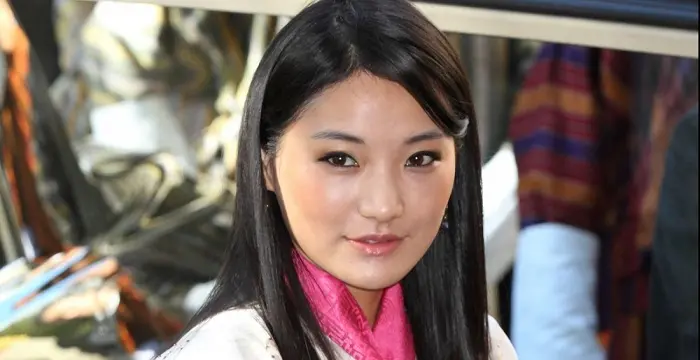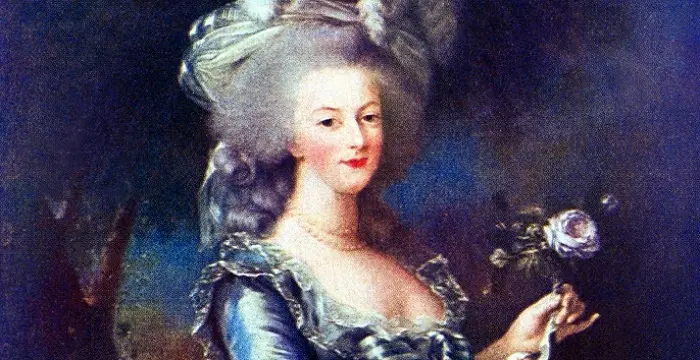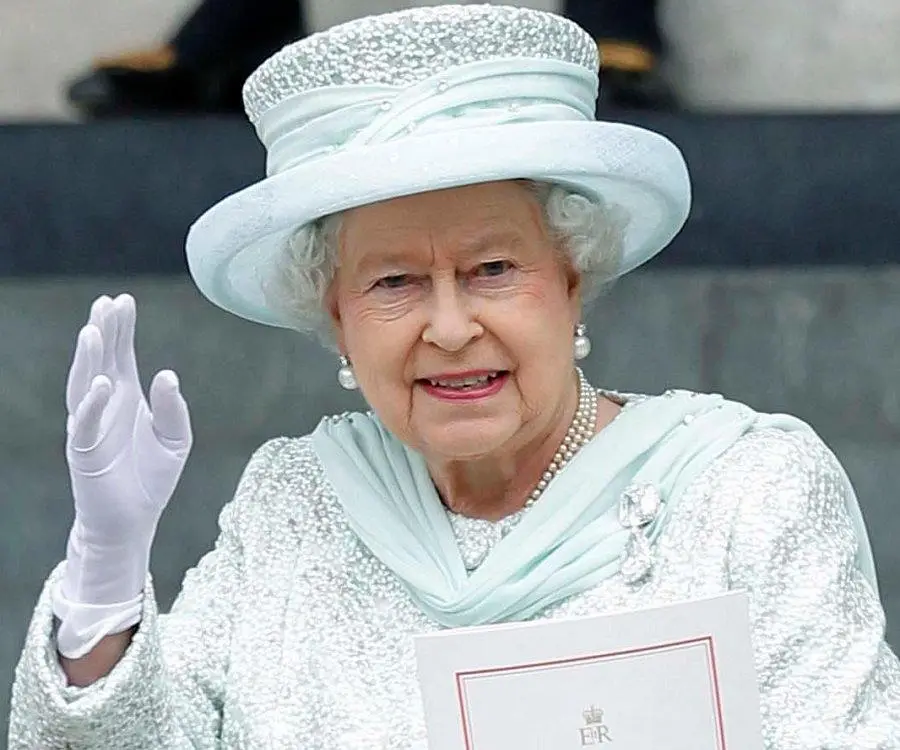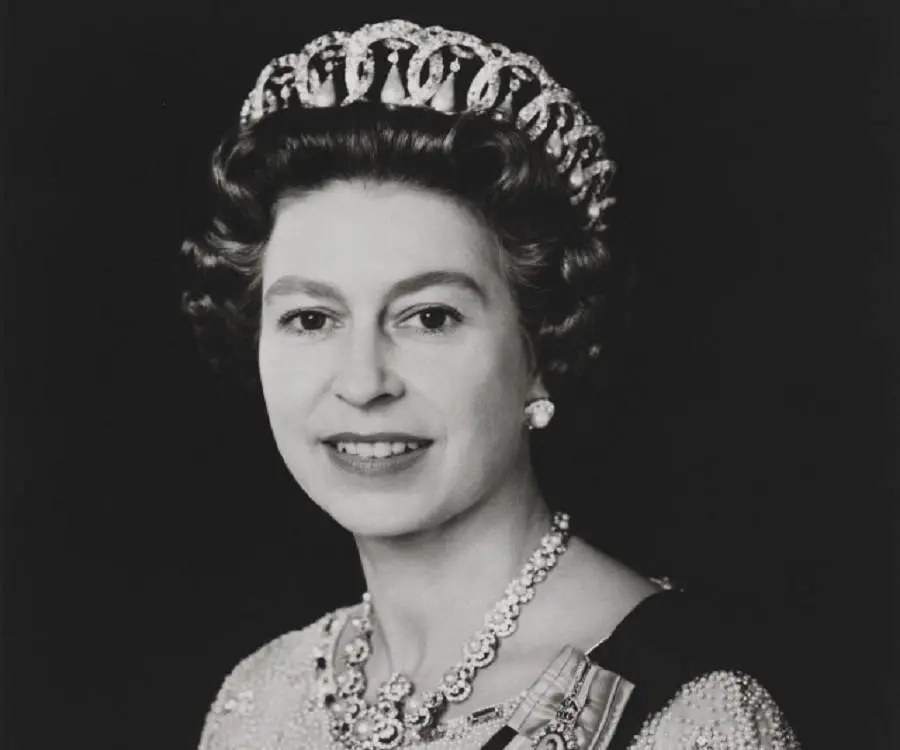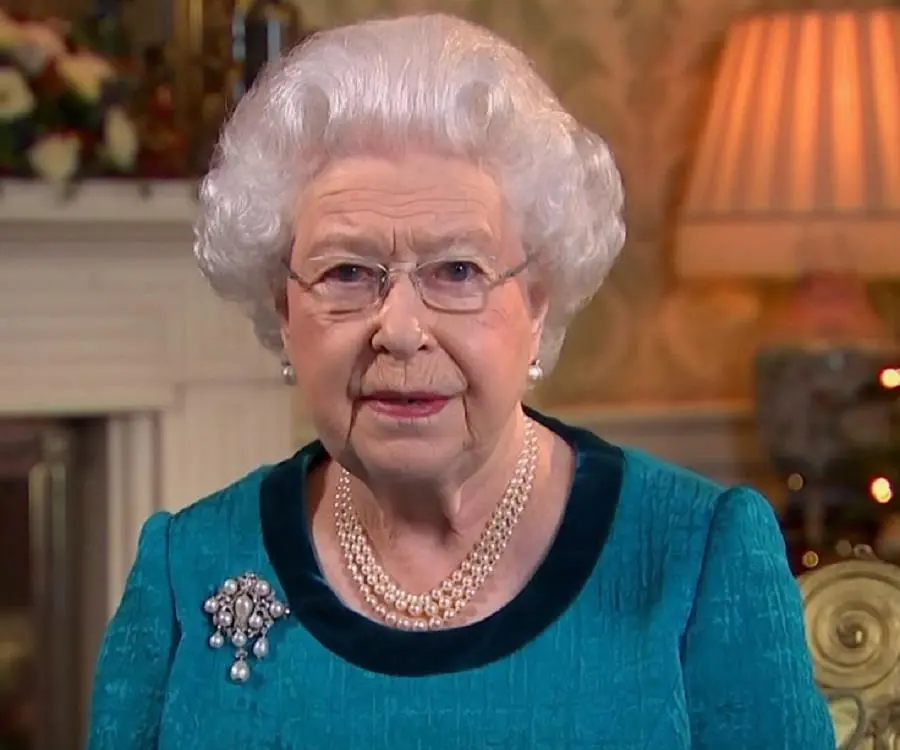
Queen Elizabeth II - Empresses, Facts and Family
Queen Elizabeth II's Personal Details
Queen Elizabeth II is the reigning monarch and the ‘Supreme Governor of the Church of England’
| Information | Detail |
|---|---|
| Birthday | April 21, 1926 |
| Nationality | British |
| Famous | Historical Personalities, Empresses & Queens, ISTJ, Empresses, Queen of the United Kingdom, Queens |
| Spouses | Prince Philip |
| Siblings | Princess Margaret |
| Known as | Elizabeth II, Elizabeth Alexandra Mary |
| Childrens | Princess Anne |
| Birth Place | Mayfair, London |
| Religion | Anglican/Episcopalian |
| Height | 163 |
| Gender | Female |
| Father | King George VI |
| Mother | Elizabeth Bowes-Lyon |
| Net Worth | $550 million as of Apr 14,2017 |
| Sun Sign | Taurus |
| Born in | Mayfair, London |
| Famous as | Queen of the United Kingdom |
// Famous Empresses
Jetsun Pema
Jetsun Pema is the Queen consort of Bhutan. Check out this biography to know about her childhood, family life, achievements and fun facts about her life.
Princess Alice of Battenberg
Princess Andrew of Greece and Denmark, also known as Princess Victoria Alice Elizabeth Julia Marie of Battenberg, was the mother of Prince Philip, Duke of Edinburgh and mother-in-law of Queen Elizabeth II. This biography profiles her childhood, famil
Marie Antoinette
Marie Antoinette was the Queen of France and Navarre from 1774 to 1792. who played a major role in provoking the French Revolution. This biography of Marie Antoinette provides detailed information about her childhood and life
Queen Elizabeth II's photo
Who is Queen Elizabeth II?
‘Supreme Governor of the Church of England’ and ‘The Defender of the Faith’, Her Majesty Queen Elizabeth II is the constitutional monarch and serves as the head of Commonwealth Nations. Reserved and introvert, the queen has been revered by her subjects for displaying impeccable moral character, administrative acumen and unequivocal empathy towards all factions of the society, throughout her life. Once, mesmerized by her larger-than-life persona, filmmaker Michael Waldman quipped, “The more time I spent filming Our Queen, the more I was struck by the strange idiosyncrasies of her life”. The fact that she is both the only female royal to have joined the military services and the only head of the state alive to have served in the military during World War II bears testimony to her loyalty and devotion towards her country and countrymen. Post the tumultuous phase of the Second World War, Elizabeth, the ‘fairy tale queen’, ushered England in an era of hope and prosperity, thus promulgating a ‘new Elizabethan age’. Patron of innumerable charitable organizations, this magnanimous monarch, has also been the subject of a few controversies and speculations. Read on and learn more about all the aspects pertaining to the queen’s illustrious life.
// Famous Queens
Jetsun Pema
Jetsun Pema is the Queen consort of Bhutan. Check out this biography to know about her childhood, family life, achievements and fun facts about her life.
Princess Alice of Battenberg
Princess Andrew of Greece and Denmark, also known as Princess Victoria Alice Elizabeth Julia Marie of Battenberg, was the mother of Prince Philip, Duke of Edinburgh and mother-in-law of Queen Elizabeth II. This biography profiles her childhood, famil
Marie Antoinette
Marie Antoinette was the Queen of France and Navarre from 1774 to 1792. who played a major role in provoking the French Revolution. This biography of Marie Antoinette provides detailed information about her childhood and life
Early Life
Born to Prince Albert, Duke of York and Elizabeth, daughter of Scottish aristocrat Claude Bowes-Lyon, Elizabeth II is the grand-daughter of King George V and Queen Mary.
Elizabeth, with her sister Margaret, started her education at home and learned history, French, mathematics, geography along with dancing, singing and art.
Her unruffled childhood took a decisive turn when her grandfather King George V passed away and her uncle Edward VIII abdicated the throne in 1936 to be with his lady love and twice divorcee, Wallis Simpson. Consequently, Elizabeth’s father was crowned king and she became the crown princess and next in line to the throne.
World War II & Military Services
During the outbreak of the Second World War, London was subjected to heavy bombardment and Elizabeth and her sister were shifted to Balmoral Castle, Scotland where they stayed until Christmas of 1939. They were later sent to Sandringham House, Norfolk amidst growing concern for their safety.
Till May 1940, she stayed at the Royal Lodge, Windsor, and was later shifted to Windsor Castle where she spent several years.
She was appointed as the Colonel-in-Chief of Grenadier Guards in 1942 and, a year later, she made her first solo public appearance and went to visit the infantry regiment. She also served as one of five Counselors of State in July 1944 when her father, King George VI, was on his trip to Italy.
In 1945, she was appointed to the Women's Auxiliary Territorial Service as an honorary Second Subaltern. Here, she was trained as a driver and mechanic and, within a few months, became Junior Commander of the regiment.
As Princess Elizabeth
Soon, Princess Elizabeth started accompanying her parents on official trips both within England and abroad.
She was inducted into the Welsh Gorsedd of Bards at the National Eisteddfod of Wales in 1946. A year later, on her first official visit with her parents, she travelled through the South African countries.
In 1951, owing to her father’s declining health, she visited Canada and the USA in his stead, as the heir apparent.
Ascension To The Throne & Reign
While she was on her tour to Kenya, Australia and New Zealand with her husband, her father, King George VI passed away and she was proclaimed the sovereign of the Commonwealth realms over 6th and 7th February 1952.
After her return from Kenya, it was anticipated that the royal house would bear the name of her husband and henceforth be known as the House of Mountbatten.
However, on the insistence of Queen Mary and the then British Prime Minister Winston Churchill, Elizabeth retained the name ‘House of Windsor’. She was coronated at Westminster Abbey on 2nd June 1953 in the first ever coronation ceremony to be televised.
During an impasse within the Conservative Party, the queen was bestowed the responsibility of appointing the leader of the party and, heeding the advice of the British cabinet and Winston Churchill, she appointed Harold Macmillan.
She visited United States in 1957 and addressed the United Nations General Assembly as a representative of the Commonwealth Nations. The same year, she also visited Canada and opened the session for the 23rd Canadian parliament, the first monarch of Canada to do so.
In the 1960s and & 70s, the African and the Caribbean countries were rapidly decolonizing and were becoming sovereign states. During the Australian constitutional crisis, her decision of not interfering in the constitutional matter of the country speeded up Australian Republicanism.
Following the victory in the 1991 Gulf War, the Queen addressed a joint session of the United States Congress and became the first British monarch to do so. In her speech in 1992, the year commemorating her 40th anniversary as the queen, she called the year of 1992, her ‘annus horribilis’, meaning the horrible year.
In 2002, the queen celebrated her Golden Jubilee as a monarch and embarked on a trip across her realm, starting in Jamaica in the Caribbean. In 2010, she addressed the United Nations for the second time and, a year later, visited the Republic of Ireland, the first British monarch to do so.
2012 witnessed Elizabeth’s ‘Diamond Jubilee’ as the queen of England and, in July of the same year, she opened both the Olympic and Paralympic games. Later this year, she also became the first sovereign after King George III to have participated in the peace-time Cabinet meeting.
Death Threats & Controversies
While riding a horse in a parade during her birthday celebrations in June 1981, near the Buckingham Palace, she was shot at by a teenager, Marcus Sarjeant. The next year another man broke into her personal bedchamber; fortunately she didn’t get hurt in any of the incidents.
After Princess Diana’s death in 1997, her silence generated a lot of speculations and the rumour that she had declined to give Diana a public funeral, hurt the general sentiment.
Media reports claimed that the queen was "exasperated and frustrated" by the policies of British Prime Minister Tony Blair; a claim that generated a lot of controversy.
Personal Life & Legacy
Elizabeth got married to Prince Philip of Greece and Denmark, her second cousin once removed through King Christian IX of Denmark and third cousin through Queen Victoria, on 20 November 1947 at Westminster Abbey.
Her first son, Prince Charles was born on 14 November, 1948 and, a couple of years later, she also gave birth to Princess Anne. Prince Andrew was born in 1960 while Prince Edward, her fourth child, was born in 1964.
In 1969, she declared Prince Charles her successor and bestowed upon him, the title of Prince of Wales. Prince Charles got married to 19-year-old Diana Spencer in 1981.
Awards & Achievements
On 4 April 2013, she received an honorary BAFTA for her patronage of the film industry, and was called "the most memorable Bond girl yet" at the award ceremony.
Trivia
Though during her reign she has travelled across many countries, this longest serving British monarch doesn’t hold a passport.
To buy her wedding dress, she used ration coupons in order to abide by the postwar austerity measures.
This monarch is particularly fond of dogs and loves to read mystery novels and, during her leisure time, watches wrestling on television.
Queen Elizabeth II biography timelines
- // 1936Her unruffled childhood took a decisive turn when her grandfather King George V passed away and her uncle Edward VIII abdicated the throne in 1936 to be with his lady love and twice divorcee, Wallis Simpson. Consequently, Elizabeth’s father was crowned king and she became the crown princess and next in line to the throne.
- // 1939During the outbreak of the Second World War, London was subjected to heavy bombardment and Elizabeth and her sister were shifted to Balmoral Castle, Scotland where they stayed until Christmas of 1939. They were later sent to Sandringham House, Norfolk amidst growing concern for their safety.
- // May 1940Till May 1940, she stayed at the Royal Lodge, Windsor, and was later shifted to Windsor Castle where she spent several years.
- // 1942She was appointed as the Colonel-in-Chief of Grenadier Guards in 1942 and, a year later, she made her first solo public appearance and went to visit the infantry regiment. She also served as one of five Counselors of State in July 1944 when her father, King George VI, was on his trip to Italy.
- // 1945In 1945, she was appointed to the Women's Auxiliary Territorial Service as an honorary Second Subaltern. Here, she was trained as a driver and mechanic and, within a few months, became Junior Commander of the regiment.
- // 1946She was inducted into the Welsh Gorsedd of Bards at the National Eisteddfod of Wales in 1946. A year later, on her first official visit with her parents, she travelled through the South African countries.
- // 20th Nov 1947Elizabeth got married to Prince Philip of Greece and Denmark, her second cousin once removed through King Christian IX of Denmark and third cousin through Queen Victoria, on 20 November 1947 at Westminster Abbey.
- // 1951In 1951, owing to her father’s declining health, she visited Canada and the USA in his stead, as the heir apparent.
- // 1952While she was on her tour to Kenya, Australia and New Zealand with her husband, her father, King George VI passed away and she was proclaimed the sovereign of the Commonwealth realms over 6th and 7th February 1952.
- // 2nd Jun 1953However, on the insistence of Queen Mary and the then British Prime Minister Winston Churchill, Elizabeth retained the name ‘House of Windsor’. She was coronated at Westminster Abbey on 2nd June 1953 in the first ever coronation ceremony to be televised.
- // 1957She visited United States in 1957 and addressed the United Nations General Assembly as a representative of the Commonwealth Nations. The same year, she also visited Canada and opened the session for the 23rd Canadian parliament, the first monarch of Canada to do so.
- // Jun 1981While riding a horse in a parade during her birthday celebrations in June 1981, near the Buckingham Palace, she was shot at by a teenager, Marcus Sarjeant. The next year another man broke into her personal bedchamber; fortunately she didn’t get hurt in any of the incidents.
- // 1991Following the victory in the 1991 Gulf War, the Queen addressed a joint session of the United States Congress and became the first British monarch to do so. In her speech in 1992, the year commemorating her 40th anniversary as the queen, she called the year of 1992, her ‘annus horribilis’, meaning the horrible year.
- // 1997After Princess Diana’s death in 1997, her silence generated a lot of speculations and the rumour that she had declined to give Diana a public funeral, hurt the general sentiment.
- // 2002In 2002, the queen celebrated her Golden Jubilee as a monarch and embarked on a trip across her realm, starting in Jamaica in the Caribbean. In 2010, she addressed the United Nations for the second time and, a year later, visited the Republic of Ireland, the first British monarch to do so.
- // 20122012 witnessed Elizabeth’s ‘Diamond Jubilee’ as the queen of England and, in July of the same year, she opened both the Olympic and Paralympic games. Later this year, she also became the first sovereign after King George III to have participated in the peace-time Cabinet meeting.
- // 4th Apr 2013On 4 April 2013, she received an honorary BAFTA for her patronage of the film industry, and was called "the most memorable Bond girl yet" at the award ceremony.
// Famous Historical Personalities
Sundiata Keita
Sundiata Keita was the founder of the Mali Empire in West Africa. This biography profiles his childhood, early life, struggles, founding of empire, rule, administration, achievements and also gives some fun facts.
Ashoka
Ashoka was the third emperor of the Mauryan Dynasty and ruled almost the entire Indian subcontinent. This biography profiles his childhood, life, reign, achievements and timeline
Jetsun Pema
Jetsun Pema is the Queen consort of Bhutan. Check out this biography to know about her childhood, family life, achievements and fun facts about her life.
Murad IV
Murad IV was one of the mighty Sultans in the history of the Ottoman Empire. This biography profiles his childhood, family, accession, rule, administration and timeline.
Xerxes I
Xerxes I (Xerxes the Great) was the fourth and the most famous king of the Archaemenid dynasty of Persia. This biography profiles his childhood, family, personal life, life history, achievements, campaigns, administration, death and other facts.
Sargon of Akkad
Sargon of Akkad, also called ‘Sargon the Great’, ‘Sarru-Kan’ and ‘Shar-Gani-Sharri’, was the founder and first king of the Akkadian Empire. This biography profiles his childhood, life, rule, administration, timeline, and gives some fun facts.
Queen Elizabeth II's FAQ
What is Queen Elizabeth II birthday?
Queen Elizabeth II was born at 1926-04-21
Where is Queen Elizabeth II's birth place?
Queen Elizabeth II was born in Mayfair, London
What is Queen Elizabeth II nationalities?
Queen Elizabeth II's nationalities is British
Who is Queen Elizabeth II spouses?
Queen Elizabeth II's spouses is Prince Philip
Who is Queen Elizabeth II siblings?
Queen Elizabeth II's siblings is Princess Margaret
Who is Queen Elizabeth II childrens?
Queen Elizabeth II's childrens is Princess Anne
What is Queen Elizabeth II's religion?
Queen Elizabeth II's religion is Anglican/Episcopalian
How tall is Queen Elizabeth II?
Queen Elizabeth II's height is 163
Who is Queen Elizabeth II's father?
Queen Elizabeth II's father is King George VI
Who is Queen Elizabeth II's mother?
Queen Elizabeth II's mother is Elizabeth Bowes-Lyon
What is Queen Elizabeth II's sun sign?
Queen Elizabeth II is Taurus
How famous is Queen Elizabeth II?
Queen Elizabeth II is famouse as Queen of the United Kingdom
